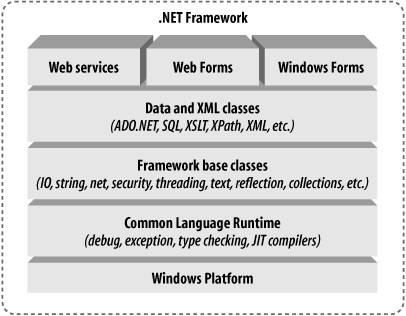Section 1.1. .NET Framework 2.0
1.1. .NET Framework 2.0The .NET Framework sits on top of the operating system, which can be any recently released version of Windows, including Windows 2000, Windows XP, or Windows Server 2003. Currently, the .NET Framework consists of:
The .NET Framework is an integral part of Windows Server 2003 but must be downloaded and installed to run on Windows 2000 or Windows XP.
Figure 1-1 breaks down the .NET Framework into its architectural components . Figure 1-1. .NET Framework architecture The CLR executes your program on your web server. The CLR activates objects, performs security checks on them, lays them out in memory, executes them, and handles garbage collection. In Figure 1-1, the layer on top of the CLR is a set of framework base classes, followed by an additional layer of data and XML classes, plus another layer of classes intended for web services, web sites, and Windows forms. Collectively, these classes are known as the FCL. With more than 5,000 classes, the FCL facilitates rapid development of ASP.NET applications.
The .NET Framework supports a Common Language Specification (CLS) , which allows you to choose the syntax with which you are most comfortable. You can write classes in C# and derive from them in Visual Basic 2005 (VB2005). You can throw an exception in VB2005 and catch it in a C# class. Suddenly the choice of language is a personal preference rather than a limiting factor in your application's development. The set of Framework base classes supports rudimentary input and output, string manipulation, security management, network communication, thread management, text manipulation, reflection, and collections functionality , and so on. Above the base class level are classes that support data management and XML manipulation. The data classes support persistent management of data that are maintained on backend databases. These classes include the Structured Query Language (SQL) classes to let you manipulate persistent data stores through a standard SQL interface. Additionally, a set of classes called ADO.NET allows you to manipulate persistent data. There are classes optimized for the Microsoft SQL Server relational database, and there are generic classes for interacting with OLE DB compliant databases. The .NET Framework also supports a number of classes to let you manipulate XML data and perform XML searching and translations. Chapter 10 discuss the data-handling aspects of the .NET Framework. Beyond the Framework base classes and the data and XML classes is yet another tier of classes geared to support three types of application:
|
EAN: 2147483647
Pages: 173
